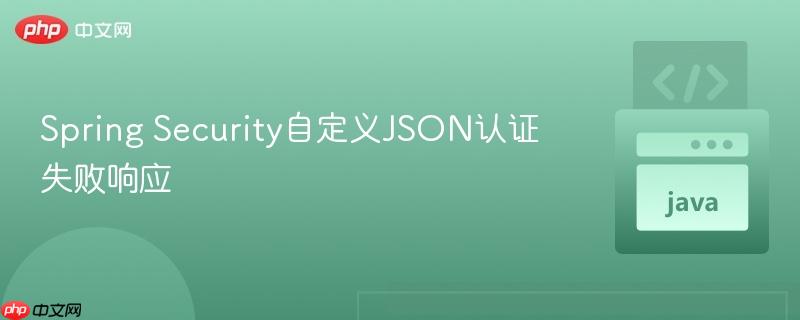
本文详细介绍了如何在spring security中自定义认证入口点(authenticationentrypoint),以实现在用户未认证访问受保护资源时,返回格式化的json错误响应而非默认的html页面。通过配置`customauthenticationentrypoint`并直接向`httpservletresponse`写入json数据,开发者可以为api客户端提供更友好、一致的错误处理机制。
在构建RESTful API时,统一的错误响应格式至关重要。Spring Security在处理未认证请求时,默认会返回一个HTML格式的错误页面(例如HTTP Status 401 Unauthorized)。这对于浏览器客户端可能适用,但对于需要JSON格式响应的API客户端来说,这种默认行为并不理想。本教程将指导您如何通过自定义AuthenticationEntryPoint来解决这一问题,从而返回结构化的JSON错误信息。
当Spring Security检测到未经认证的请求尝试访问受保护资源时,它会触发AuthenticationEntryPoint。默认情况下,这通常会导致浏览器重定向到登录页或返回一个包含HTML内容的401 Unauthorized响应。对于API消费者而言,期望的响应通常是如下所示的JSON格式:
{
"errors": [
{
"status": "401",
"title": "UNAUTHORIZED",
"detail": "认证失败或缺少认证凭据"
}
]
}而实际收到的可能是:
<!doctype html>
<html lang="en">
<head>
<title>HTTP Status 401 – Unauthorized</title>
<!-- ... 样式 ... -->
</head>
<body>
<h1>HTTP Status 401 – Unauthorized</h1>
</body>
</html>显然,这种HTML响应不适用于API客户端的自动化解析。
要实现JSON格式的认证失败响应,我们需要创建一个自定义的AuthenticationEntryPoint实现。这个类将负责在认证失败时,直接向HttpServletResponse写入我们期望的JSON数据。
首先,定义您的自定义AuthenticationEntryPoint:
import com.fasterxml.jackson.databind.ObjectMapper;
import org.springframework.http.HttpStatus;
import org.springframework.http.MediaType;
import org.springframework.security.core.AuthenticationException;
import org.springframework.security.web.AuthenticationEntryPoint;
import org.springframework.stereotype.Component;
import javax.servlet.http.HttpServletRequest;
import javax.servlet.http.HttpServletResponse;
import java.io.IOException;
import java.io.PrintWriter;
import java.util.Collections;
import java.util.Map;
@Component
public class CustomAuthenticationEntryPoint implements AuthenticationEntryPoint {
private final ObjectMapper objectMapper = new ObjectMapper();
@Override
public void commence(HttpServletRequest request, HttpServletResponse response,
AuthenticationException authException) throws IOException {
// 设置响应内容类型为JSON
response.setContentType(MediaType.APPLICATION_JSON_VALUE);
// 设置HTTP状态码为401 Unauthorized
response.setStatus(HttpStatus.UNAUTHORIZED.value());
// 可选:添加WWW-Authenticate头部,对于Basic认证是必要的
response.addHeader("WWW-Authenticate", "Basic realm=\"Realm\"");
// 构建JSON错误体
Map<String, Object> errorDetails = Map.of(
"status", String.valueOf(HttpStatus.UNAUTHORIZED.value()),
"title", HttpStatus.UNAUTHORIZED.name(),
"detail", authException.getMessage() != null ? authException.getMessage() : "认证失败或缺少认证凭据"
);
Map<String, Object> errorResponse = Collections.singletonMap("errors", Collections.singletonList(errorDetails));
// 将JSON写入响应体
try (PrintWriter writer = response.getWriter()) {
objectMapper.writeValue(writer, errorResponse);
}
}
}代码解析:
接下来,您需要在Spring Security的配置类中注册并使用这个自定义的AuthenticationEntryPoint。
import org.springframework.context.annotation.Configuration;
import org.springframework.http.HttpMethod;
import org.springframework.security.config.annotation.web.builders.HttpSecurity;
import org.springframework.security.config.annotation.web.configuration.EnableWebSecurity;
import org.springframework.security.config.annotation.web.configuration.WebSecurityConfigurerAdapter;
@Configuration
@EnableWebSecurity
public class SecurityConfiguration extends WebSecurityConfigurerAdapter {
private final CustomAuthenticationEntryPoint customAuthenticationEntryPoint;
// 通过构造器注入自定义的AuthenticationEntryPoint
public SecurityConfiguration(CustomAuthenticationEntryPoint customAuthenticationEntryPoint) {
this.customAuthenticationEntryPoint = customAuthenticationEntryPoint;
}
@Override
protected void configure(HttpSecurity httpSecurity) throws Exception {
httpSecurity
.csrf().disable() // 禁用CSRF保护,通常API不需要
.authorizeRequests()
.antMatchers(HttpMethod.GET, "/public/**").permitAll() // 允许GET请求访问/public/**路径
.anyRequest().authenticated() // 其他所有请求都需要认证
.and()
.httpBasic() // 启用HTTP Basic认证
.and()
.exceptionHandling()
.authenticationEntryPoint(customAuthenticationEntryPoint); // 指定自定义的认证入口点
}
}配置解析:
为了验证我们的自定义AuthenticationEntryPoint是否按预期工作,我们可以编写一个集成测试。这里使用Spring Boot Test和MockMvc来模拟HTTP请求。
package com.example.security.custom.entrypoint;
import org.junit.jupiter.api.Test;
import org.springframework.beans.factory.annotation.Autowired;
import org.springframework.boot.test.autoconfigure.web.servlet.WebMvcTest;
import org.springframework.context.annotation.Import;
import org.springframework.test.web.servlet.MockMvc;
import static org.springframework.test.web.servlet.request.MockMvcRequestBuilders.*;
import static org.springframework.test.web.servlet.result.MockMvcResultHandlers.print;
import static org.springframework.test.web.servlet.result.MockMvcResultMatchers.*;
@WebMvcTest // 仅加载Web层相关的Bean
@Import({SecurityConfiguration.class, CustomAuthenticationEntryPoint.class}) // 导入Security配置和EntryPoint
class SecurityCustomEntrypointApplicationTests {
@Autowired
private MockMvc mvc;
@Test
void testUnauthorizedAccessReturnsJson() throws Exception {
mvc
.perform(post("/somewhere")) // 模拟一个未认证的POST请求到受保护的路径
.andDo(print()) // 打印请求和响应详情,便于调试
.andExpectAll(
status().isUnauthorized(), // 期望HTTP状态码是401
header().exists("WWW-Authenticate"), // 期望响应头中存在WWW-Authenticate
jsonPath("$.errors[0].detail").exists(), // 期望JSON路径errors[0].detail存在
jsonPath("$.errors[0].title").value("UNAUTHORIZED"), // 期望JSON路径errors[0].title的值是"UNAUTHORIZED"
jsonPath("$.errors[0].status").value(401) // 期望JSON路径errors[0].status的值是401
);
}
}测试解析:
通过自定义Spring Security的AuthenticationEntryPoint,您可以轻松地将默认的HTML认证失败响应替换为结构化的JSON响应。这对于构建现代RESTful API至关重要,它能确保API客户端获得一致且易于解析的错误信息,从而提升用户体验和系统可维护性。结合ObjectMapper和严谨的测试,您可以构建出健壮且专业的API错误处理机制。
以上就是Spring Security自定义JSON认证失败响应的详细内容,更多请关注php中文网其它相关文章!

每个人都需要一台速度更快、更稳定的 PC。随着时间的推移,垃圾文件、旧注册表数据和不必要的后台进程会占用资源并降低性能。幸运的是,许多工具可以让 Windows 保持平稳运行。

Copyright 2014-2025 https://www.php.cn/ All Rights Reserved | php.cn | 湘ICP备2023035733号